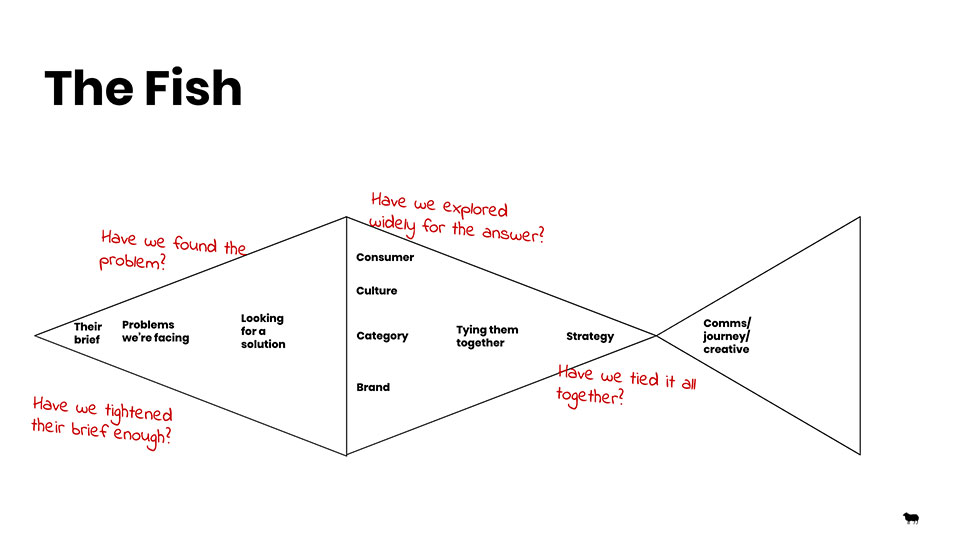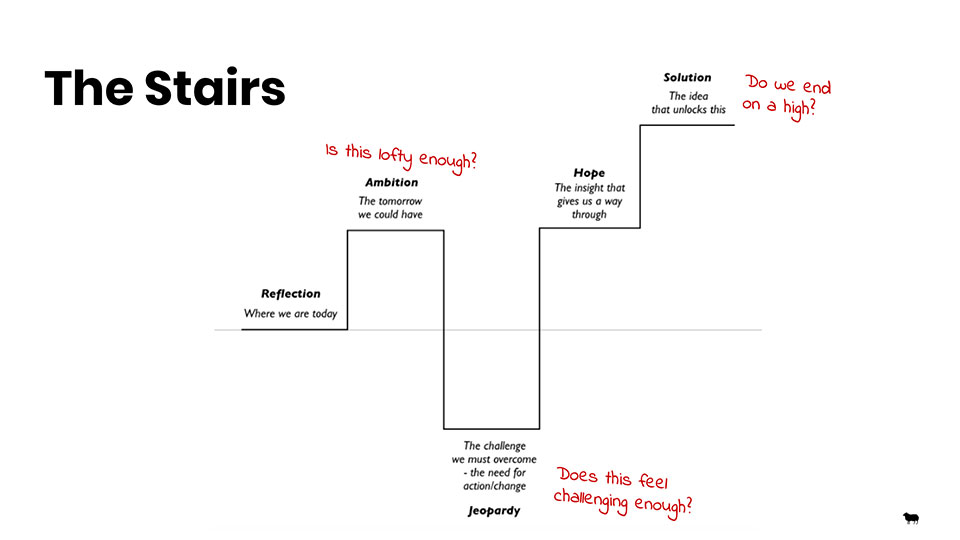Everyone has an opinion on creative work. Whether you have the word ‘creative’ in your title or not, it seems accepted in most good agencies that, as creative humans, we will all have a natural reaction to the work, that we should voice. The same is not always true of strategy. Even in a strategic agency like BBH, you still often find there is less discussion around our product than the creative one. Which got me wondering why that is.
One option, of course, is that we have bored everyone into apathy. I have certainly been rendered mute by 100 slides of a debrief so know the feeling. Another option is perhaps we’ve convinced people that commentary on strategy is only for those who understand a brand onion or can decipher a complex chart. There is a virulent stream of strategy that overintellectualizes rather than simplifies, and our skillset has arguably done a good job of making our work more esoteric than it needs to be. Or perhaps it is that your strategist has genuinely convinced you of their argument and you have nothing to add.
The issue with all this is that it is a strategist’s job to be convincing; to marshal the available data into a cogent and inspiring argument that feels inevitable. If they are doing their job you should feel convinced, but that does not mean it is the only, or the best, answer. In fact, there are some very good reasons why we should all be forming and voicing opinions on the strategy.
Creative zags start with strategic zags
It might be painfully obvious, but if we brief something generic, we will likely get generic work. With limitless time, creatives might be able to dig us out of our strategic hole, but we rarely have that luxury. So, the role of strategy is to accelerate us past the boring answers towards those that are inherently more tension-filled and different.
We spent weeks trying to crack a brief for the relaunch of the Amex Delta Skymiles partnership that was based around ‘momentum’ but the work all felt disconnected. It wasn’t until we landed on the strategy ‘it matters how you get there’ that we landed the idea of redefining travel status from points to feelings.
So, we should be judging strategies with the same rigor we do the creative, as by that point the interesting horse might have bolted.
Creative solves problems that strategy identifies
We’re not are not in the business of creative for creative sake but are here to use creativity as a problem-solving tool. Creativity is a weapon when applied to the right problem but becomes pretty useless if pointed in the wrong direction. This starts with admitting there is a problem (an honest first step required in any intervention) and requires a debate on whether we’re defining the problem in the right way. If we get this initial definition wrong, all the work might be wrong, so best to get your comments in early when they can have a disproportionate impact on the outcome.
A strategy is inherently subjective
We present strategy as the singular answer (and sorry we are probably are not going to stop doing that), but it never is. A strategy is a point of view. It is a stance that we take because we believe it to be ‘right’ but also interesting. So, by definition, there has to be an ingredient in a strategy that you could disagree with because it signals that we have made choices. Conversely, if there’s nothing to disagree with, chances are it is bland and not yet tight enough. This issue often rears its head in the insight section, where you find some of the more blandly agreeable statements (I dread to think how many briefs are currently being written around the idea of connection in a time of disconnection). So, no prior knowledge or understanding of data is required, an opinion is a bellwether for whether our strategy has teeth.
Convinced?
Well even if you’re not, as I’ve just spent a bunch of words convincing you that you should distrust that feeling, I have a few pointers on how you might want to argue with your strategist should you feel the urge to start challenging them.
Arguments have a shape and fail in consistent places
A good brief or deck or strategy is an argument that has tension built into it, and that tension is created by it having a shape. Depending on your school of thought it is either the shape of a fish (thanks Jim Carroll) or some stairs (thanks Martin Weigel).

 In each you can challenge the various points in it – is the ambition lofty enough, are the challenges we face large and perilous enough, and does our solution tie together those strands into a neat and inspiring bow.
In each you can challenge the various points in it – is the ambition lofty enough, are the challenges we face large and perilous enough, and does our solution tie together those strands into a neat and inspiring bow.
A convincing argument can be challenged
No matter how convincing the argument there are a few things to look out for that might be fooling the audience into believing it is more convincing than it should be.
- Flawed starting assumptions
Wrong-headed assumptions are often baked into a client brief and if we don’t challenge them, whatever argument comes afterward is probably not right. Some common misconceptions are we know who the audience is or that the audience feels exactly as we do. That is rarely the case as we know the advertising industry skews liberal, white, and coastal. Another common misconception is we need to drive brand love or engagement, when all the data suggests people don’t love or engage with brands, they are just aware of them and buy them if we occupy enough of their mental and physical space.
- Misuse of data
Every planner has at some point cherry-picked a data point that supports the argument, or over-sampled to find the agreeable human in a focus group who said what we wanted them to. Data is no replacement for a strong point of view so however robust it seems, look for the interestingness before believing all the data.
- Right but not interesting
Which brings me to perhaps the most important point – is it right but not interesting? An alcohol brand was working from the insight that it created ‘non-agenda connection moments.’ That’s not inherently untrue (though you could also word it as ‘people hang out’ which begins to feel less interesting), but it might not be the most exciting way in. I always loved the dumb simplicity of Bailey’s strategy that it is half booze, half cake.
- It’s a stretch
Often a strategy will fall down in its final moments. The consumer, category, brand, and business strands are all plates in the air that need tying together into a single-minded thought and they just don’t quite make it. In creative we say, ‘long walk for a ham sandwich’ and that long walk often begins with a strategy that meanders through information without landing a thought.
- Closes vs Opens
Lastly, does the single-minded thought create a springboard to creative work or does it close down options? The smartest strategy in the world isn’t worth the paper it is printed on if it can’t be executed.
Do it with empathy
The final piece of advice is that just like reviewing creative work, a strategy has had time and effort put into it and deserves an empathetic response. So, challenge away, but channel Mr. Rogers.


I like the intent of the article, but disappointed to see that it’s just another article on craft/technique/process. Especially with what’s happening right now in the world, strategy leads should be challenging us to think about how our discipline can change, expand and embrace new voices, not rehash old craft lessons.
“A strategy is a point of view.” Exactly. The most urgent question in our discipline right now is whether we have welcomed, and benefitted from enough different points of views (Spoiler: We haven’t).
The world is demanding more from us morally, and substantively, but here we are still talking about fishes and stairs.
Thanks for the comment. Totally agree. It was written before this moment so now feels it’s willfully blind. Strategy does have an imperative to create povs that are representative and we have been shit as an industry in making that happen.
That said I’m not the person to be writing think pieces on that topic. I have no authority to speak confidently on race as a white man. I have a platform I can use and personally do, but professionally my focus is on action not talking about it. Having listened to the advice of BIPOC colleagues and commentators, the consensus seems to be do something vs speak publicly. So I am focusing on that. Think-pieces on diversity and inclusion can wait (Or be written by someone more experienced than me) until real change has happened.